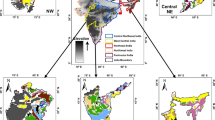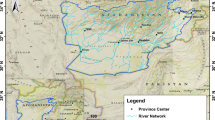Abstract
Assessment of spatio-temporal variability in groundwater storage (GWS) is critical for effective water resource planning and management with rational groundwater use. Haean Basin comprising 64 km2 area, mainly depends on groundwater for agricultural, domestic and other water uses. For quantification of GWS variability, sufficient field-based hydrological data of the ongoing decade (2011–2017) were interpolated in ArcGIS, to give reliable results. Despite satellite remote sensing having advantages in the field of hydrology, the limitation of accessibility at larger spatial resolution (~ 200,000 km2) is making it non-applicable for fine-scale observations. From the surface area, saturated thickness and specific yield of aquifer, a decline of 33 million cubic meters in GWS volume was indicated from 230 to 197 during the observed 6 years. An observable drop (4.6 m) in the mean water level due to increased water use (0.49 MCM) during this decade is responsible for the change in the mean groundwater level. A changing water level can change the surface area and saturated thickness of aquifer that have a positive correlation with GWS, and act as main controlling factors for GWS change. An annual recharge of 0.14 m to the total amount of GWS is near negligible, considering the long-term sustainability of groundwater resource. A shift towards more use of surface water, and limited drilling of groundwater wells is recommended for rational water use. The findings of this study will provide basic knowledge for relating studies, specifically which are based on small (local) scale distribution of groundwater resource.








Similar content being viewed by others
References
Akther H, Ahmed MS, Rasheed KBS (2010) Spatial and temporal analysis of groundwater level fluctuation in Dhaka City, Bangladesh. Asia J Earth Sci 3(4):222–230
Alley WM, Konikow LF (2015) Bringing GRACE down to earth. Groundwater 53(6):826–829
Alley WM, Healy RW, LaBaugh JW, Reilly TE (2002) Flow and storage in groundwater systems. Science 296(5575):1985–1990
An JH, Hamm SY, Lee JH, Kim NH, Yang DB, Hwang JG (2008) Estimation of groundwater recharge in Junggwae-Boeun Area in Ulsan City using the water balance and hydrogeological analyses. Econ Environ Geol 41(4):427–442
Apaydin A (2010) Response of groundwater to climate variation: Fluctuations of groundwater level and well yields in the Halacli aquifer (Cankiri, Turkey). Environ Monit Assess 165(1–4):653–663
Arlai P, Lukjan A, Koch M (2012) 3-D groundwater model to estimate the dynamic groundwater storage in Viang Papao Aquifers System. Proc Eng 32:1221–1227. https://doi.org/10.1016/j.proeng.2012.02.080
Bhanja SN, Rodell M, Li B, Saha D, Mukherjee A (2017) Spatio-temporal variability of groundwater storage in India. J Hydrol 544:428–437
Cheema MJM, Immerzeel WW, Bastiaanssen WGM (2014) Spatial quantification of groundwater abstraction in the irrigated Indus basin. Groundwater 52(1):25–36
Choi YH (2000) South Korea’s water resources policy toward the 21st century: conflicting views. Int J Urban Sci 4(1):16–25
Choi IH, Woo NC, Kim SJ, Moon SK, Kim J (2007) Estimation of the groundwater recharge rate during a rainy season at a headwater catchment in Gwangneung, Korea. Korean J Agric Forest Meteorol 9(2):75–87
Chung IM, Kim NW, Lee J, Sophocleous M (2010) Assessing distributed groundwater recharge rate using integrated surface water-groundwater modelling: application to Mihocheon watershed, South Korea. Hydrogeol J 18(5):1253–1264
Dixon RM (2003) Use of a GIS-based hydrogeologic database to estimate groundwater storage volumes and annual recharge volumes within the Entiat River valley, Chelan County, Washington. In: Washington State Department of Ecology. 6 p. Washington Department of Ecology draft unpublished report. Prepared for the Entiat WRIA Planning Unit. Yakima, WA. WDOE Central Regional Office, Olympia
Doll P, Hoffmann-Dobrev H, Portmann FT, Siebert S, Eicker A, Rodell M, Scanlon BR (2012) Impact of water withdrawals from groundwater and surface water on continental water storage variations. J Geodyn 59:143–156. https://doi.org/10.1016/j.jog.2011.05.001
Feng W, Zhong M, Lemoine JM, Biancale R, Hsu HT, Xia J (2013) Evaluation of groundwater depletion in North China using the Gravity Recovery and Climate Experiment (GRACE) data and ground-based measurements. Water Resour Res 49(4):2110–2118
Forootan E, Rietbroek R, Kusche J, Sharifi MA, Awange JL, Schmidt M, Famiglietti J (2014) Separation of large scale water storage patterns over Iran using GRACE, altimetry and hydrological data. Remote Sens of Environ 140:580–595
Freeze RA, Cherry JA (1979) Groundwater. Prentice Hall, New Jersey, pp 604
GIMS (2016) Characteristics of groundwater in Korea. Chapter 1. Integrated Groundwater Information Service. http://www.gims.go.kr. Accessed 8 Jan 2018
GIMS (2017) Groundwater survey annual report. Integrated groundwater information service 1995–2017. http://www.gims.go.kr. Accessed 20 Dec 2017
Gleeson T, Moosdorf N, Hartmann J, Beek LPH (2014) A glimpse beneath earth’s surface: global hydrogeology maps (GLHYMPS) of permeability and porosity. Geophys Res Lett 41(11):3891–3898
Gleeson T, Befus KM, Jasechko S, Luijendijk E, Cardenas MB (2016) The global volume and distribution of modern groundwater. Nat Geosci. https://doi.org/10.1038/ngeo2590
GSI (2016) Gangwon statistical information (population). http://stat.gwd.go.kr/. Accessed 22 Nov 2017
Healy RW, Cook PG (2002) Using groundwater levels to estimate recharge. Hydrogeol J 10(1):91–109
Hinaman KC (2005) Hydrogeologic framework and estimates of ground-water volumes in Tertiary and upper Cretaceous hydrogeologic units in the Powder River basin, Wyoming. US Department of the Interior, US Geological Survey
Hoekstra AY, Mekonnen MM (2016) Imported water risk: the case of the UK. Environ Res Lett 11(5):055002. https://doi.org/10.1088/1748-9326/11/5/055002
Hughes JD, Petrone KC, Silberstein RP (2012) Drought, groundwater storage and stream flow decline in southwestern Australia. Geophys Res Lett 39(3):1–6
Kim H, Lee JY, Lee KK (2014) Thermal characteristics and bacterial diversity of forest soil in the Haean Basin of Korea. Sci World J 247401:1–12
Kim H, Kaown D, Mayer B, Lee JY, Hyun Y, Lee KK (2015) Identifying the sources of nitrate contamination of groundwater in an agricultural area (Haean basin, Korea) using isotope and microbial community analyses. Sci Tot Environ 533:566–575
Korea M Agency KMA (2014) http://www.kma.go.kr. Accessed 25 Feb 2014
Korea National Committee on Large Dams (KNCOLD) (2017) http://www.kncold.or.kr/eng/ds6_1.html. Accessed 12 Dec 2017
Korea Rural Development Corporation, Gangwon (2010) Fundamental research and development of groundwater basic maintenance, survey, and impact investigation report
Kumar PS, Delson PD, Vernon JG, James EJ (2013) A linear regression model (LRM) for groundwater chemistry in and around the Vaniyambadi industrial area, Tamil Nadu, India. Chin J Geochem 32(1):19–26
Lee JY, Han J (2013) Groundwater use and its perspective in Haean Basin, Yanggu County of Gangwon Province. J Wetl Res 15(2):179–189
Lee JY, Kwon KD (2016) Current status of groundwater monitoring networks in Korea. Water 8(4):168. https://doi.org/10.3390/w8040168
Lee JY, Lee KS, Park Y, Choi HM, Jo YJ (2013) Chemical and isotopic compositions of groundwater and stream water in a heavy agricultural basin of Korea. J Geol Soc India 82(2):169–180
Lee JY, Lee KK, Hamm SY, Kim Y (2017) Fifty years of groundwater science in Korea: a review and perspective. Geosci J 21(6):951–969
Lee JY, Kwon KD, Raza M (2018) Current water uses, related risks, and management options for Seoul megacity, Korea. Environ Earth Sci 77(1):14. https://doi.org/10.1007/s12665-017-7192-6
Li B, Rodell M, Famiglietti JS (2015) Groundwater variability across temporal and spatial scales in the central and northeastern US. J Hydrol 525:769–780. https://doi.org/10.1016/j.jhydrol.2015.04.033
MacDonald AM, Bonsor HC, Dochartaigh BE, Taylor RG (2012) Quantitative maps of groundwater resources in Africa. Environ Res Lett 7(2):024009. https://iopscience.iop.org/article/10.1088/1748-9326/7/2/024009/meta
MacDonald AM, Bonsor HC. Ahmed KM, Burgess WG, Basharat M, Calow RC, Dixit A, Foster SSD, Gopal K, Lapworth DJ, Lark RM, Moench M, Mukherjee A, Rao MS, Shamsudduha M, Smith L, Taylor RG, Tucker J, Steenbergen FV, Yadav SK, Lark RM (2016) Groundwater quality and depletion in the Indo-Gangetic basin mapped from in situ observations. Nat Geosci 9(10):762–766
Meusburger K, Mabit L, Park JH, Sandor T, Alewell C (2013) Combined use of stable isotopes and fallout radionuclides as soil erosion indicators in a forested mountain site, South Korea. Biogeosciences 10(8):5627–5638
Ministry of Land, Infrastructure and Transport (MOLIT), Kwater (2015) Groundwater Annual Report. Kwater, Daejeon, p 645 (in Korean)
Miro ME, Famiglietti JS (2018) Downscaling GRACE remote sensing datasets to high-resolution groundwater storage change maps of California’s Central Valley. Remote Sens 10(1):143. https://doi.org/10.3390/rs10010143
Nam WH, Choi JY, Hong EM (2015) Irrigation vulnerability assessment on agricultural water supply risk for adaptive management of climate change in South Korea. Agric Water Manag 152:173–187. https://doi.org/10.1016/j.agwat.2015.01.012
Narany TS, Ramli MF, Aris AZ, Sulaiman WNA, Fakharian K (2014) Spatiotemporal variation of groundwater quality using integrated multivariate statistical and geostatistical approaches in Amol–Babol Plain, Iran. Environ Monitor Assess 186(9):5797–5815
Oh HJ, Kim YS, Choi JK, Park E, Lee S (2011) GIS mapping of regional probabilistic groundwater potential in the area of Pohang City, Korea. J Hydrol 399(3–4):158–172
Organization for Economic Co-operation and Development (OECD) (2015) Drying wells, rising stakes towards sustainable agricultural groundwater use. OECD Publishing, Paris. https://doi.org/10.1787/9789264238701-en
Pandey VP, Shrestha S, Kazama F (2013) A GIS-based methodology to delineate potential areas for groundwater development: a case study from Kathmandu Valley, Nepal. Appl Water Sci 3(2):453–465
Prasad NN (2003) Assessment of groundwater resource in Nileshwar River basin. J Appl Hydrol 16(3):52–60
Ratner B (2009) The correlation coefficient: its values range between +1/−1, or do they? J Targ Meas Anal Market 17(2):139–142
Richey AS, Thomas BF, Lo MH, Famiglietti JS, Swenson S, Rodell M (2015) Uncertainty in global groundwater storage estimates in a total groundwater stress framework. Water Resour Res 51(7):5198–5216
Rijsberman FR (2006) Water scarcity: fact or fiction? Agri Water Manag 80(1–3):5–22
Seo B, Bogner C, Poppenborg P, Martin E, Hoffmeister M, Jun M, Tenhunen J (2014) Deriving a per-field land use and land cover map in an agricultural mosaic catchment. Earth Syst Sci Data 6(2):339–352
Shope CL, Maharjan GR, Tenhunen J, Seo B, Kim K, Riley J, Kim B (2014) Using the SWAT model to improve process descriptions and define hydrologic partitioning in South Korea. Hydrol Earth Syst Sci 18(2):539–557
Siebert S, Burke J, Faures JM, Frenken K, Hoogeveen J, Doll P, Portmann FT (2010) Groundwater use for irrigation—a global inventory. Hydrol Earth Syst Sci 14(10):1863–1880
United States Geological Survey USGS (2017) Earth explorer. https://earthexplorer.usgs.gov. Accessed 10 July 2017
Wada Y, Vanbeek LPH, Vankempen CM, Reckman JWTM, Vasak S, Bierkens MFP (2010) Global depletion of groundwater resources. Geophys Res Lett 37:L20402. https://doi.org/10.1029/2010GL044571
Wahyuni S, Oishi S, Sunada K (2008) The estimation of the groundwater storage and its distribution in Uzbekistan. Proc Hydraul Eng 52:31–36
Yan SF, Yu SE, Wu YB, Pan DF, Dong JG (2018) Understanding groundwater table using a statistical model. Water Sci Eng 11(1):1–7
Yun SW, Jo YJ, Lee JY (2009) Comparison of groundwater recharges estimated by water level fluctuation and hydrograph separation in Haean basin of Yanggu. J Geol Soc Korea 45(4):391–404
Acknowledgements
This work was supported by the National Research Foundation of Korea (NRF) grant, funded by the Korean government (MSIT) (No. NRF-2015R1A4A1041105) and Basic Science Research Program through the National Research Foundation of Korea (NRF) funded by the Ministry of Education (NRF-2018R1D1A1B07047200).
Author information
Authors and Affiliations
Corresponding author
Ethics declarations
Conflict of interest
The authors declare that they have no conflict of interest.
Additional information
Publisher’s Note
Springer Nature remains neutral with regard to jurisdictional claims in published maps and institutional affiliations.
Rights and permissions
About this article
Cite this article
Raza, M., Lee, JY. & Kwon, K.D. Estimation of quantitative spatial and temporal distribution for groundwater storage in agricultural basin of Korea: implications for rational water use. Environ Earth Sci 78, 169 (2019). https://doi.org/10.1007/s12665-019-8179-2
Received:
Accepted:
Published:
DOI: https://doi.org/10.1007/s12665-019-8179-2




